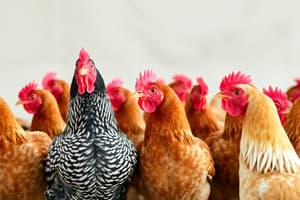Podcast
Questions and Answers
What is the main reason Chickens have gotten bigger over the years?
What is the main reason Chickens have gotten bigger over the years?
To create a fast-growing meat product that provides a larger amount of protein at an affordable cost.
How much has the size of modern broiler Chickens changed since the 1950s?
How much has the size of modern broiler Chickens changed since the 1950s?
Modern broilers are four times the size they were in the 1950s.
What is the average life span of chickens bred for meat?
What is the average life span of chickens bred for meat?
Around 38-39 days
What Modern technology does modern Chicken farming use?
What Modern technology does modern Chicken farming use?
What were the goals of the 'Chicken-of-Tomorrow' competition in America?
What were the goals of the 'Chicken-of-Tomorrow' competition in America?
What are the consequences of selective breeding for chickens?
What are the consequences of selective breeding for chickens?
Flashcards are hidden until you start studying
Study Notes
- Chickens are the most populous bird species on the planet, with approximately 23 billion at any given time, which is 10 times more than any other bird.
- Chickens have undergone a significant transformation from a wild jungle bird in South East Asia to the fastest-growing meat product, with chickens being first domesticated over 8,000 years ago.
- In the 1940s, efforts were made to create a super breed of chicken, leading to the "Chicken-of-Tomorrow" competition in America, which encouraged the development of a fast-growing chicken that could provide a larger amount of protein at an affordable cost.
- Modern industrialized chicken farming relies on technology, such as CCTV and CO2 monitors, to control the environment and raise chickens efficiently.
- Chickens have grown significantly in size over the years, with modern broilers being four times the size they were in the 1950s, and they have a pre-ordained life cycle that is entirely controlled through technology.
- Chickens bred for meat, known as broilers, have a short life span of around 38-39 days, and the farming process is highly efficient, passing the savings onto consumers.
- Selective breeding on a global scale has come at a cost, as chickens that live beyond their planned life face significant health problems and put pressure on their internal organs.
- Organic and free-range chickens offer a greater quality of life but are more expensive than intensively reared birds, with over 95% of broiler chickens in the UK being intensively reared.
- Consumers are largely driven by cost, and the demand for cheap and plentiful chicken continues to drive the industry to breed chickens evermore intensively.
Studying That Suits You
Use AI to generate personalized quizzes and flashcards to suit your learning preferences.




